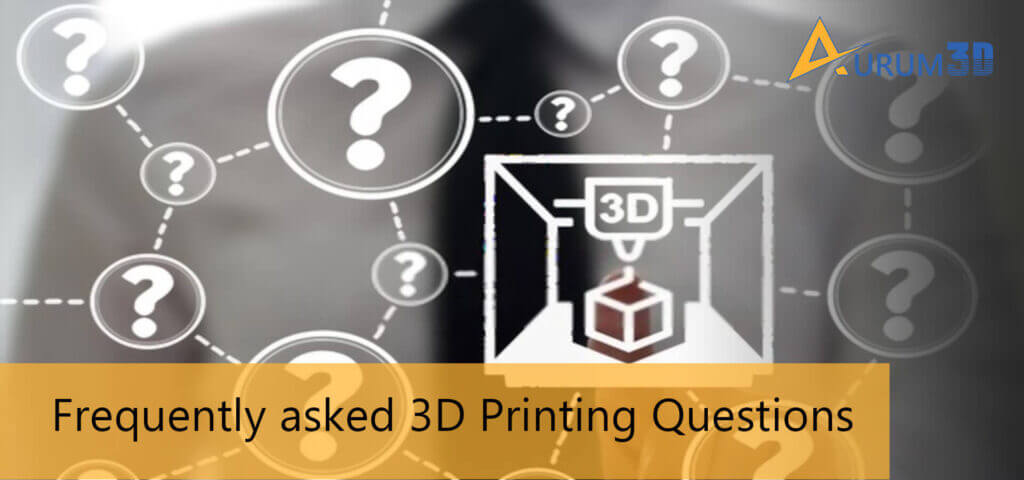3D printing or additive manufacturing is one of the new-age technologies that has been impacting and transforming many industries. At the same time, 3D printing technologies create opportunities for many hobbyists, enthusiasts, and professionals to convert their innovative ideas into solid three-dimensional objects.
But 3D printing is still at a nascent stage in many countries. A large percentage of hobbyists, students, and professionals still lack access to 3D printers. We are trying to make enthusiasts familiar with this emerging and disruptive technology by answering some of the frequently asked 3D printing questions.
Answering 11 Frequently Asked 3D Printing Questions
1) What is 3D printing?
3D printing or additive manufacturing is a new-age manufacturing process that facilitates the production of solid three-dimensional objects through a series of stages. 3D printers produce objects physically by gathering inputs from three-dimensional digital models. They build the object or model physically by depositing material or filament layer by layer according to the digital 3D model. However, the printing process varies across 3D printing technologies.
2) How does 3D printing technology work?
A 3D printer builds the desired object or item by interpreting the digital 3D model. The digital model prepared by you needs to be sliced or prepped to provide the 3D printer with the required information and instructions. The 3D printer will build the object physically by depositing a single layer of material at a time according to the sliced 3D model. But you must remember that each type of 3D printer builds the object physically in a specific way.
3) What are the three important stages in 3D printing?
Additive manufacturing or 3D printing is a multistage process. An object or item is 3D-printed in three important stages – preparation/pre-processing, building, and finishing/post-processing. In the pre-processing stage, the digital file is prepared and processed based on which the 3D printer will print the item. The 3D printer builds the object in the building stage by depositing filament layer by layer according to the digital file. Finally, the 3D-printed item is removed from the support structure and cleaned or painted during the post-processing or finishing stage.
4) Can I 3D print items of varying shapes?
You can use a 3D printer to produce physical objects of varying shapes and sizes from digital 3D models. But you cannot use a single 3D printer to produce items of varying types and sizes. You must keep in mind the build volume to choose and use the right 3D printer.
5) What should I consider before 3D printing an item?
You cannot convert a three-dimensional digital file into a solid three-dimensional object without using the appropriate 3D printing technology and filament. That is why; you must focus on combining the right 3D printing technology and filament by considering the object’s size, shape, resolution, wall thickness, and orientation. At the same time, you also need to focus on both pre-processing and post-processing activities to ensure that the 3D-printed object meets predefined requirements.
6) How long does it take to 3D print an object?
Some 3D printing technologies are faster than others. Hence, the printing time will vary according to your choice of 3D printing technology. Also, the size and shape of the object will impact the 3D printing time directly. For instance, you will need more time to 3D print a larger item than a smaller item.
7) What are widely used 3D printing technologies?
You have the option to choose from a wide range of 3D printing technologies according to the precise needs of the item to be 3D-printed. Each 3D printing technology forms the solid three-dimensional object by depositing and curing filament in a specific way. That is why; you must keep in mind the differences between widely used 3D printing technologies like Fused Deposition Modeling (FDM), Stereolithography (SLA), Selective Laser Sintering (SLS), Digital Light Processing (DLP), and Selective Laser Melting (SLM).
8) Can choose from a wide range of 3D printing materials?
While 3D printing an object, you have the option to choose from a wide range of materials or filaments. But you must remember that 3D printing materials differ from each other in many aspects, including physical and chemical properties. That is why; you must keep in mind the nature, requirements, and usage of the 3D-printed item to choose the perfect filament for your 3D printing project.
9) Can I 3D print an item without investing in a 3D printer?
You can avail of professional 3D printing services to convert your ideas into a three-dimensional item without buying either a 3D printer or 3D printing filaments. Professional 3D printing service providers create three-dimensional objects based on your digital file combining the right 3D printer and filament. Hence, you can 3D print the desired item simply by sharing your idea with the 3D printing service provider in the form of a digital file.
10) What are the common applications and use cases of 3D printing?
At present, 3D printing technologies are being used by enterprises from various industries. Hence, the applications and use cases of 3D printing vary across industries. For instance, healthcare companies use 3D printers to manufacture and test a variety of customized health devices and surgical instruments. At the same time, educational institutions leverage 3D printing to facilitate STEM education. Also, enterprises from various sectors have been creating new use cases of 3D printing technologies regularly.
11) How much does a 3D printer cost?
You have the option to choose from a wide range of industrial and desktop 3D printers. Industrial 3D printers are more expensive than consumer 3D printers. You can buy one of the basic 3D printer models by spending less than $ 200. But you have to spend more to buy high-end and sophisticated 3D printers.
Beginners can easily understand the significance and impact of 3D printing technologies by asking a slew of questions. But they must remember that 3D printing technologies have been evolving consistently. They can convert their ideas into physical objects only by combining the right 3D printing technology and filament.

